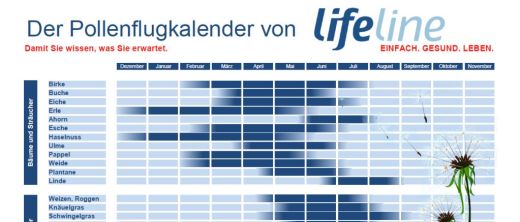Written according to the highest scientific standards and checked by experts
People who suffer from hay fever can use a pollen calendar and current forecasts to prepare specifically. They know when they are threatened with complaints from pollen and can take appropriate countermeasures.
-
- Pollen allergy sufferers can use flight calendars to prepare for the pollen count.
- © Lifeline.de
Pollen allergy sufferers who react with hay fever, allergic asthma or in any other way when they come into contact with certain grass or tree pollen have a hard time avoiding the allergens – after all, you cannot see the pollen and you cannot always avoid it. To make this situation easier, the German Pollen Information Service Foundation (PID) has been recording pollen counts in Germany since 1983, evaluating it scientifically and making the data available to the public.
The measurements of the current pollen count are now carried out at around 40 locations across Germany with the help of pollen traps. In addition, there is a cooperation with the German Weather Service (DWD), which has around 400 observers reporting so-called phenological data and the plant growth phases in nature, especially the beginning of flowering of hazel, alder, birch, grass and other plants.
Pollen calendar for download
The pollen calendar reminds you when hazel, birch, grass and mugwort fly. To download, print and hang on the wall!
Why pollen forecast?
The Center for Medical-Meteorological Research of the DWD evaluates the pollen measurements of the PID, the phenological data of the DWD and the weather forecast together. In this way, it creates up-to-date forecasts of the pollen flight of the eight most important pollen pollen from an allergological perspective, from which around 95 percent of pollen allergy sufferers suffer: hazel, alder, ash, birch, grass, rye, mugwort and ambrosia.
Pollen count: what flies when?
TargetVideo
The beginning of flowering of the plants and thus the pollen count can fluctuate up to six weeks in Central Europe due to the weather. In addition, the concentration of the released pollen and its transport depend crucially on the current weather. These predictions for the pollen count are made available via the media, telephone announcement services and the DWD website.
According to the DWD, a study in North Rhine-Westphalia showed that, with the help of the information service for pollen counts, the drugs could be used more specifically in pollen allergy sufferers, which on the one hand maintains performance in school and work and on the other hand the number of days of incapacity for work due to hay fever complaints reduced. In addition, the daily forecasts make diagnostics easier for the doctor and self-assessment for allergy sufferers, the DWD continues.
Click here for the current PID forecast for pollen count.
Do you have a question?
Would you like information on specific symptoms or medical advice? Here you can put your questions to our experts or other Lifeline users!


